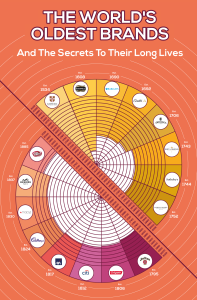Live Long and Prosper: The Secret to Brand Longevity
Everyone wants a brand that will live on for many years, basking in long-lasting success. But few brands actually reach old age, and those that do definitely have something going for them.
Recently, Unum, a financial insurance company, put together an infographic of some of the world’s oldest brands, highlighting those who all can boast founding years prior to 1890.
As can be expected, a list of brands from across the industry spectrum seem to have little in common on the surface, but throughout the infographic a common theme emerges. Each of these enduring and successful brands have long-ago identified how they can differentiate themselves from the competition, and put that quality (or qualities) as the centerpiece of their branding.
This is a lesson that can be applied to newly formed startups still finding their way, as well as brands that have an extensive history. In either situation, the key is finding out where you brand will fit into the landscape of your marketplace – for instance, does your brand have a highly recognizable visual branding element like Cadbury’s unique purple color scheme and “glass and a half” logo? Then establish your branding around maximizing this element and connecting the rest of your brand strategy to its focus.
Your unique characteristic doesn’t have to just be a physical part of your brand – it can also emanate from your audiences’ view of what the brand represents. This is especially beneficial for older brands, as they have a wealth of history to search and find their outstanding characteristic.
The oldest brand on this list, the Cambridge University Press, was founded in 1534 (given their charter by Henry VII and holding the title of the world’s oldest publishing house) and is arguably the benchmark for brand longevity.
So what’s their secret? Well, their success can partly be attributed to their gleaming reputation. Know around the world as one of the preeminent publishing brands, they have endured throughout nearly half of a millennium of literary trends and publishing evolution, growing the Press around the world and being the home of some of the greatest titles in history.
But the job doesn’t stop when the differentiation is identified. What these brands have done, along with many other successful brands, is stick to the script – that is, they take the best aspect(s) of their brand and continue to improve and enhance, instead of consistently changing.
Evolution of a brand isn’t necessarily a path to failure, but instead is dependent on smart evolution. Using keen brand strategy to know when and how much to evolve, in addition to knowing how to keep your core intact during any changes.
While startups and newer brands are devoid of well-established reputations or traditions, they are in the often-enviable position of shaping their original brand strategy around the best characteristics of their brand. Without previous iterations to shape the strategic planning, they are presented with a clean slate of branding directions and areas of potential differentiation that will hopefully land them on a “world’s oldest brands” list a few centuries from now.
So whether you are a founding member of a new and exciting organization, or a part of a brand older than some nations, a clear focus on differentiation and a commitment to put it at the center of your branding will go a long way in extending your brand’s lifespan.
Addison Whitney is a global branding firm with a passion for building strong brands.
To learn more about Addison Whitney, visit our website at AddisonWhitney.com, or contact us here.
